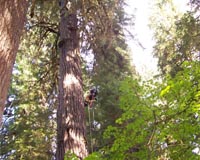| . |  |
. |
Kinshasa (AFP) July 28, 2009 Greenpeace has urged authorities in the Democratic Republic of Congo to clarify reforms bringing transparency to the logging sector in the world's second biggest rainforest after the Amazon. The "objective is still far from being reached," the global environment campaign group said in a letter to the minister of the environment, a copy of which was given to AFP on Tuesday. "It is urgent to have clarifications of the current situation, marked by irregularities." Since 2002, the Congolese government has obtained World Bank support in a plan to convert existing logging rights into concessions and impose a temporary freeze on further concessions. The aim was to bring order to the sector and cut down the illegal logging of precious timber. Greenpeace said that reforms "seem to be only a figleaf that can barely hide the anarchy in the exloitation of lumber, both industrially and by artisans, in the forested provinces." It said there have been serious abuses, and that it was worried about "the opacity surrounding implementation" of the reforms. The Congolese government should "not miss out on the opportunities presented by international attention to the exceptional wealth of Congolese forests," Greenpeace said in the letter. Among "serious irregularities," Greenpeace cited a difference of 2.9 million hectares of forest where logging was allowed between the 9.7 million hectares officially announced at the beginning of 2009 and the 12.6 million shown on a ministry of the environment map. "The government has now committed to a legal review of the logging industry and we are calling on them to maintain and enforce the moratorium - withdrawing any illegal concessions," Greenpeace said in a separate statement on its website. "Currently the review is characterised by secrecy and sloppiness so we're demanding the international community and the DRC Government ensure this review process is completely transparent, the moratorium is maintained and enforced and that a participatory land use plan is put in place," it said. The organisation also protested at special exemptions granted to concession holders whose rights were invalid and the failure of the government to publish a list of logging companies currently authorised to work in the vast central African country. There is also concern for the well-being of the estimated 500,000 Pygmies living in the rainforest. "The communities see the loggers come to cut and take away wood. Their role is reduced to that of helpless witnesses of the degradation of their forests and their means of subsistence," Greenpeace said in the letter. "It is time to save the primary forests still intact in the DR Congo and to support models of management that are genuinely sustainable and of local development that benefit the Congolese." After the Amazon in Brazil, Congo has the second largest rainforest on the planet at 86 million hectares (212 million acres), of which nearly 60 million hectares (148 million acres) are exploitable. It also constitutes about 60 percent of all forests in the Congo basin. Share This Article With Planet Earth
Related Links Forestry News - Global and Local News, Science and Application
 Smaller Plants Punch Above Their Weight In The Forest
Smaller Plants Punch Above Their Weight In The ForestLondon, UK (SPX) Jul 16, 2009 New findings from Queen's University biologists show that in the plant world, bigger isn't necessarily better. "Until now most of the thinking has suggested that to be a good competitor in the forest, you have to be a big plant," says Queen's Biology professor Lonnie Aarssen. "But our research shows it's virtually the other way around." Previous studies revealed that larger plant species ... read more |
|
| The content herein, unless otherwise known to be public domain, are Copyright 1995-2009 - SpaceDaily. AFP and UPI Wire Stories are copyright Agence France-Presse and United Press International. ESA Portal Reports are copyright European Space Agency. All NASA sourced material is public domain. Additional copyrights may apply in whole or part to other bona fide parties. Advertising does not imply endorsement,agreement or approval of any opinions, statements or information provided by SpaceDaily on any Web page published or hosted by SpaceDaily. Privacy Statement |